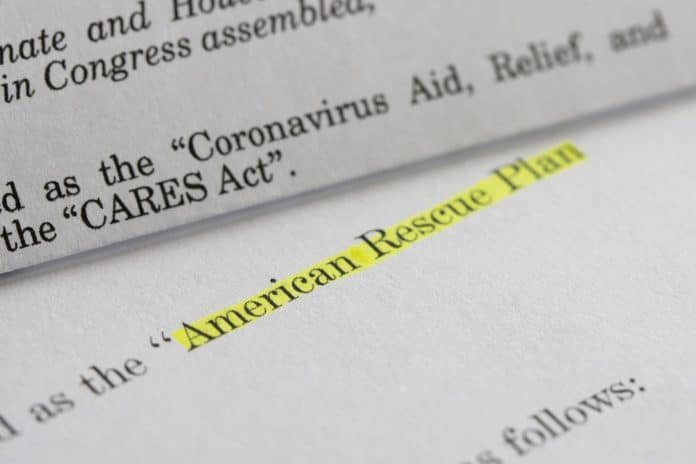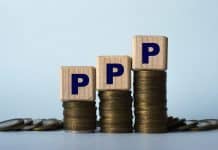
Joe Biden began his presidency with a revived plan to handle the economic impact of COVID-19. On March 11th, 2021, President Biden signed the American Rescue Plan Act of 2021 into law. The President had many ambitious goals with his plan. He wanted to:
- Raise the minimum wage to $15 an hour.
- Repeal “right to work” laws.
- Forgive student loan debt.
- Make college free for those making up to $125,000
- Provide health insurance coverage to 97% of Americans over the course of a decade.
- Raise $4 trillion more in tax revenue.
- Expand “Buy American” policies.
- Spend $2 trillion on clean energy.
- Invest $1.3 trillion in infrastructure over the course of a decade.
Understanding The American Rescue Plan
Americans first learned of President Biden’s plan on January 14th 2021 when he officially announced his $1.9 trillion COVID-19 plan of action. On March 11th 2021, he turned that plan into law. It promised $1,400 stimulus checks, vaccination rollouts, an extension of unemployment benefits, and more. It should be noted that the extended unemployment benefit will end in September 2021 and the eviction ban will expire in October 2021.
Overall the American Rescue Plan wanted to put funds towards combating the virus, improve social safety, and aid local and state governments. Some of the key parts of the plan are:
Providing Direct Aid ($1 Trillion): Qualifying Americans will receive $1,400 checks. Biden advertised $2,000 in his campaign. The $1,400 number will supplement the $600 checks that went out under former President Donald Trump. Not only were stimulus payments issued, but other forms of aid as well. The plan provided an extension of unemployment insurance until September 2021. Additional funding will go towards eviction and foreclosure moratoriums. This funding will be available until October 2021. The plan also has funding towards emergency rent, mortgage assistance, and emergency assistance for the homeless. The children and the adults are both taken care of, in this case. The plan has child care and food program funding and an update to the child care tax credit. President Biden wanted to increase the federal minimum wage to $15 an hour, but he wasn’t able to get that legislation passed.
Reopen Schools and Improve Public Health Efforts: Vaccination programs, increased testing, job opportunities for 100,000 public health workers, increased funding for personal protective equipment (PPE), and plans to reopen schools are all pieces of the American Rescue Plan. President Biden also encouraged the Occupational Safety and Health Administration (OSHA) to update their guidelines in order to better protect their workers.
Support Communities Throughout America: President Biden wanted to provide funding for public transit agencies, assist local governments that are dealing with the economic impacts of COVID-19, and provide small business financial assistance in the forms of grants and loans.
Improve Cybersecurity: This piece may sound unusual but it had a good reason. Back between March and June 2020, Russia supposedly hacked a company called SolarWinds. This cyber-attack impacted federal agencies. This hacking led to an immediate response. One specific response was to update and protect federal information technology with additional funding.
The American Rescue Plan’s Healthcare Initiative
President Biden wanted to protect the Affordable Care Act and build on it. However, he still doesn’t support Medicare-for-all. Nor does he support getting rid of private insurance. If he were to get rid of private insurance, that would mean he would get rid of Obamacare. This would have reset political negotiations that had been going on.
President Biden’s plan for healthcare is to expand Obamacare. He wants Obamacare to insure 97% of Americans. His goal is to introduce a public health insurance option that acts similarly to Medicare. This option could be premium-free to people in states that are either making less than 138% of the federal poverty level, or haven’t had their state expand Medicaid coverage.
Another goal that President Biden has is to get rid of the 400% federal poverty level income cap for qualifying individuals. He also aims to make sure that healthcare providers cannot “surprise bill” their patients with rates that are out of network, deal with market concentration within the healthcare industry, and give Medicare the chance to discuss prices with drug manufacturers. Not only does President Biden have these goals in mind, he also wants to put together an independent review board whose goal is to discuss financial guidelines for the price of drugs with no competition, stop tax deduction for prescription drug ads, support development, and reissue government funding for Planned Parenthood.
What The American Rescue Plan Means for Taxes
Improving the growth and progression of tax codes is one goal of President Biden. The American Rescue Plan aims to raise almost $4 trillion of extra revenue over the course of ten years. Some tax changes that President Biden wants to make include:
- Changing the top income tax rate from 37% to 39.6%.
- Imposing taxes on capital gains at an ordinary rate for those making over $1 million a year.
- Imposing a payroll tax for Social Security on people who make more than $400,000 a year.
- Changing top corporate tax income rate from 28% to 21%.
There are many more tax changes that President Biden wants to achieve within his American Rescue Plan! He has a lot of goals he wants to reach. For more information about the types of impacts taxes will face, you can find information online.
The American Rescue Plan Handles Student Debt
President Biden wants to make college tuition free for individuals and families who make up to $125,000 and go to either a two-year or a four-year public university or college. President Biden wanted to repeal the high-income tax cut that was detailed in the Coronavirus Aid, Relief, and Economic Security (CARES) Act to fund the education goal.
President Biden has many other federal student debt suggestions. He wants to cancel at least $10,000 of student debt per person, forgive loan remainders after two decades with zero tax burdens, temporarily pause monthly payments and interest for individuals that make below $25,000 a year, and set a limit to loan payments at 5% of unrestricted income for the rest. Not only does he have these ideas in mind, he also wants to provide even more federal government loan assistance of up to $50,000 over the course of five years for individuals that are a part of the public service industry.
The Rights of Workers
Even though President Biden wanted to raise the federal minimum wage to $15, that wasn’t accomplished. He also wanted to provide more freedoms to employee contracts so that people can discuss their pay with one another and implement more worker protections.
Rural America
Rural communities need assistance. President Biden knows this. That is why he wanted to work to assist rural communities with fair trade deals, rural broadband infrastructure, job opportunities, research initiatives for agriculture, accessibility to government resources, and expanding healthcare accessibility and training.
Increased Food Assistance
So many different aspects of American assistance have received additional support during these unprecedented times. The American Rescue Plan kept the 15% increase in Supplemental Nutrition Assistance Program (SNAP) until September 2021. Not only was the increase of benefits extended, SNAP also received an additional $1.15 billion for statewide SNAP administration until September 2023. The United States Department of Agriculture (USDA) also received more cash-value vouchers under the Women, Infants, and Children (WIC) program.
How You Should Be Preparing Yourself
Many changes are coming, which is why everyone should be prepared. The new American Rescue Plan, in comparison to the previous stimulus package, promises to be more inclusive. They achieve this by giving the $1,400 direct payments to two major left out social segments that didn’t receive the previous stimulus payments. Both adult dependents and mixed-status families may be eligible to receive stimulus payments. (Note: With this new proposal in place, mixed-status households are defined as those living together in one residence, where at least one individual is a noncitizen. This can include couples who are married legally, where one partner is a citizen and the other is not. Noncitizen parents whose child is a citizen and has a Social Security Number would also be considered mixed status as well.
Generous as it may seem, the fact that some people received $1,400 doesn’t exactly mean that they won the lottery. It means that they have just been given a temporary helping hand from the US government. You should prepare yourself and:
Prioritize your expenses
This isn’t time to be thinking about getting the next version of the Apple iPhone or what fine dining restaurant to eat at. This is the time for you to be thinking about spending on food, utilities, gas, and rent. Use the money well and if you don’t need it, then don’t spend it. Another crisis could come, and you’ll have to prepare for the possibility that there won’t be enough money for the stimulus checks.
Create a plan to save up for the next crisis
Put a little money aside every month, so that in case things begin to turn sour in the economy, you’ll have a safety net to fall on.
Prepare yourself for future tax policies
If you are concerned about possibly being forced to pay more taxes, then you shouldn’t be. As experts from Franklin & Marshall College claim, those making $400,000 or more may end up paying more taxes in the near future, but the good news is that there may be significant tax reductions for those making $160,000 or less.
Keep track of the real estate trends
If you have your money in real estate, then you should know that the property market is more likely to be affected by the pandemic than the change in administration. Recently, property values increased, and competition has soared. The housing market is facing too much demand and not enough supply. Many people trying to find homes are struggling especially if they are not financially stable. Individuals with higher incomes are able to outbid prospective lower-income buyers. People are even willing to skip out on home inspections in order to expedite the home buying process to secure a house.
Overall
The coronavirus pandemic affected millions of Americans in many ways. That is why President Joe Biden wanted to get a rescue plan together that could feasibly address as many issues as possible. He got the plan and is looking forward to helping as many Americans as possible, despite the pushback. You might find yourself feeling relief at the moment, but you should prepare yourself for the future.
Questions About The American Rescue Plan
President Biden’s American Rescue Plan goes over many different aspects for the country. It can be hard to keep up. Some key aspects that you should be aware of that are included in the plan are:
- Economic Impact Payments
- Child Tax Credit
- State and Local Fiscal Recovery Fund
- Capital Projects Fund
- Homeowner Assistance Fund
- Emergency Rental Assistance
- Small Business Credit Initiative for States
- Employee Retention Credit Programs
- Paid Leave Credit Programs
- Unemployment Assistance
- Premium Pay
Will the Government Tax Third Round Economic Impact Payments?
Luckily, this form of cash assistance is not taxable income. The money you will receive will save you from taxation and not affect your program income eligibility.
I Gave Birth in January 2021, Will My Child be Eligible for the Child Benefit?
Yes! However, it would be for your 2021 tax returns, not for 2020.


















